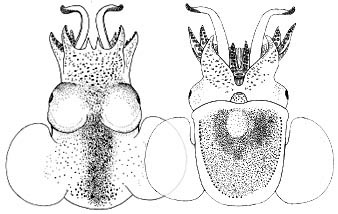Stoloteuthis
Michael Vecchione and Clyde F. E. Roper


This tree diagram shows the relationships between several groups of organisms.
The root of the current tree connects the organisms featured in this tree to their containing group and the rest of the Tree of Life. The basal branching point in the tree represents the ancestor of the other groups in the tree. This ancestor diversified over time into several descendent subgroups, which are represented as internal nodes and terminal taxa to the right.

You can click on the root to travel down the Tree of Life all the way to the root of all Life, and you can click on the names of descendent subgroups to travel up the Tree of Life all the way to individual species.
For more information on ToL tree formatting, please see Interpreting the Tree or Classification. To learn more about phylogenetic trees, please visit our Phylogenetic Biology pages.
close boxIntroduction
Stoloteuthis leucoptera, the best known species, is very common throughout the year in the Gulf of Maine at depths of 175 to 340 m. Only a few specimens have been taken on the outer shelf and slope south of Cape Cod although it is found as far south as the Straits of Florida. It has also been reported from the Mediterranean. This species, which reaches 25 mm ML, can be distinguished easily from all other neritic sepiolids in the western North Atlantic by the ventral shield of the mantle characteristic of all members of the Heteroteuthinae. Note the dramatic blue fringe to the shield in the title photograph and the silvery band of tissue around the mantle. Stoloteuthis is similar to Iridoteuthis but differs primarily in the presence of enlarged suckers on only the second arms in males and the absence of modified arm tips in females.
Diagnosis
A heteroteuthin ...
- with enlarged suckers on arms II of males.
Characteristics
- Arms
- Arm suckers relatively larger in males but no arm asymmetry present; arms I in males with larger basal suckers than females (S. leucoptera at least).
- Arms II, in males, with enlarged suckers and one to several greatly enlarged.
Figure. Oral view of brachial crown (minus tentacles) of S. maoria, mature male, off S.E. New Zealand (44°02'S, 178°08'W), otter trawl at 230-421 m. Drawing by A. Hart.
- Arm tips in females not modified.
- Funnel
- Funnel locking-apparatus with straight, simple groove.
Figure. Funnel/mantle locking-apparatus of S. leucoptera, 43°02'N, 69°04'W, NMNH 816246, left = anterior. Top - Side-oblique view of the mantle component. Bottom - Frontal view of the funnel component. Photographs by M. Vecchione.
- Mantle
- Mantle fused to head dorsally; fusion narrower than head width.
- Ventral-mantle shield of mantle does not extend beyond middle of eyes.
- Fins
- Fin margins rounded posteriorly.
Comments
S. weberi was formerly placed in Heteroteuthis. This species is reported to lack a dorsal head-mantle fusion, a feature that, if correct, would distinguish it from all other Stoloteuthis. The type specimen needs to be re-examined for this feature and the presence/absence of a nuchal cartilage. In most other features it resembles Stoloteuthis. S. maoria was formerly placed in Iridoteuthis. Harman and Seki (1990) re-examined S. maoria and found that it was similar to Iridoteuthis iris in its broad head-mantle fusion, middorsal mantle buldge and posteriorly pointed fins. We place S. maoria in Stoloteuthis on the basis of the arm modifications in mature members of both sexes which are similar to Stoloteuthis leucoptera.
Life History
Young look similar to adults.Figure. Dorsal and ventral views of young S. leucoptera, 9.8 mm ML. Drawings from Vecchione, et al. (2001).
Distribution
S. leucoptera is known from off the eastern United States and the Mediterranean Sea, S. weberi from Indonesia (7.6°S, 117.5°E) and S. maoria from off New Zealand. Unidentified species of Stoloteuthis have been reported from near the Kerguelens, Prince Edward Islands (southern Indian Ocean), Discovery Bank (Nesis, 1982/87).
References
Cairns, S. D. 1976. Biological results of the University of Miami deep-sea expeditions. 118. Cephalopods collected in the Straits of Florida by the R/V Gerda. Bull. Mar. Sci. 26: 233-272.
Nesis, K. N. 1982/87. Abridged key to the cephalopod mollusks of the world's ocean. 385+ii pp. Light and Food Industry Publishing House, Moscow. (In Russian.). Translated into English by B. S. Levitov, ed. by L. A. Burgess (1987), Cephalopods of the world. T. F. H. Publications, Neptune City, NJ, 351pp.
Orsi Relini, L. and D. Massi. 1991. The butterfly squid Stoloteuthis leucoptera in the Mediterranean. J. Mar. Biol. Ass. U. K. 71: 47-51.
Vecchione, M., C. F. E. Roper and M. J. Sweeney. 1989. Marine flora and fauna of the eastern United States. Mollusca: Cephalopoda. NOAA Tech. Rep. NMFS 73: 23 pp.
Vecchione, M., C. F. E. Roper, M. J. Sweeney and C. C. Lu. 2001. Distribution, relative abundance and developmental morphology of paralarval cephalopods in the western North Atlantic Ocean. NOAA Tech Rep. NMFS 152.
Title Illustrations
| Scientific Name | Stoloteuthis leucoptera |
|---|---|
| Location | Gulf of Maine |
| Comments | trawled in the Gulf of Maine |
| View | ventrolateral |
| Copyright | © 1996 Laurie Minor-Penland |
| Scientific Name | Stoloteuthis leucoptera(1), Stoloteuthis leucoptera (2) |
|---|---|
| Reference | from Verrill, 1881(1), from Vecchione, M., C. F. E. Roper and M. J. Sweeney. 1989. Marine flora and fauna of the eastern United States. Mollusca: Cephalopoda. NOAA Tech. Rep. NMFS 73: 23 pp. (2) |
| View | ventral(1), dorsal (2) |
About This Page
National Marine Fisheries Service
Systematics Laboratory
National Museum of Natural History
Washington, D. C. 20560
USA
Correspondence regarding this page should be directed to Clyde F. E. Roper at
Page copyright © 1996 and
Citing this page:
Vecchione, Michael and Roper, Clyde F. E. 1996. Stoloteuthis . Version 01 January 1996 (under construction). http://tolweb.org/Stoloteuthis/20033/1996.01.01 in The Tree of Life Web Project, http://tolweb.org/











